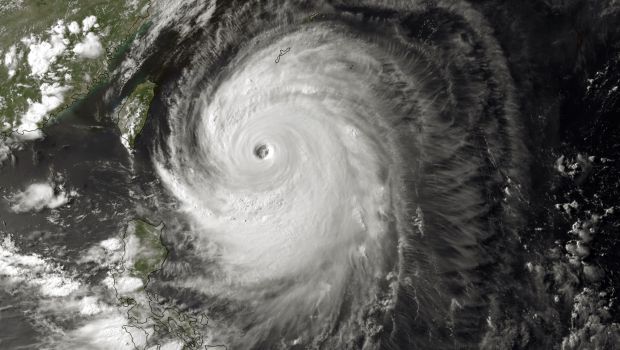
This National Oceanic and Atmospheric Administration (NOAA) satellite image obtained July 8, 2014 and taken by MTSAT-2 at 0730Z on July 7, 2014 shows Super Typhoon Neoguri located south-southwest of Kadena Air Base, Okinawa. (AFP PHOTO /NOAA/HANDOUT)
Typhoon Neoguri weakened from its original status as a super typhoon but remained intense, with gusts of more than 155 miles per hour (250 kph). It was powering through the Okinawa island chain where emergency rain and high-seas warnings were in effect.
The storm was at its most powerful when passing Okinawa, some 1,000 miles (1,600 km) southwest of Tokyo on Tuesday, but the Japan Meteorological Agency (JMA) warned of heavy rains and potential flooding in Kyushu, the westernmost of Japan’s main islands, as well as heavy rain in the rest of the nation as the storm turns east later in the week.
“People must take the utmost caution,” Keiji Furuya, state minister in charge of disaster management, told a news conference.
One man died after his boat was swamped by high waves, NHK national television said. Several people suffered minor injuries from falls.
More than 50,000 households in Okinawa lost power and an oil refinery halted operations. Television footage showed a collapsed roof of a shopping arcade, street lights rocking in high winds and branches being blown down largely deserted streets.
There are no nuclear plants on Okinawa, but there are two on Kyushu, which lies in the area through which the typhoon is likely to pass after hitting Okinawa. There is another on Shikoku island, which borders Kyushu and could also be affected.
All are shut down due to national policy and the Fukushima Daiichi nuclear plant, which was wrecked by an earthquake and tsunami in March 2011, is on the other side of the country.
“When the wind blows most strongly, it’s impossible to stand. You have to hold on to something,” said Kei Shima, a self-employed Okinawa resident in her 30s. “The lights are fading in and out, like the house is haunted. The rain is getting stronger and falling sideways.”
Neoguri was roughly 68 miles (110 km) west of Kumejima of island at 5 pm (0800 GMT) and moving north at 19 mph (30 kph), with sustained winds of 100 mph (162 kph).
Kadena Air Base, one of the largest US military facilities on Okinawa, was at its highest level of storm alert and all outside activity was prohibited.
Nansei Sekiyu KK, a Japanese refiner wholly owned by Brazil’s Petrobras, said it had suspended oil refining operations at its 100,000 barrels-per-day Nishihara refinery in Okinawa on Monday evening.
A JMA official said the storm will maintain its strength as it heads north but gradually turn to the east, making landfall in Kyushu before raking its way up the main island of Honshu and coming close to Tokyo on Friday.
“But it will be weaker by then, so that Tokyo can mainly expect a lot of rain, and maybe some gusts of wind,” he added.
Around two to four typhoons make landfall in Japan each year but they are unusual in July.
